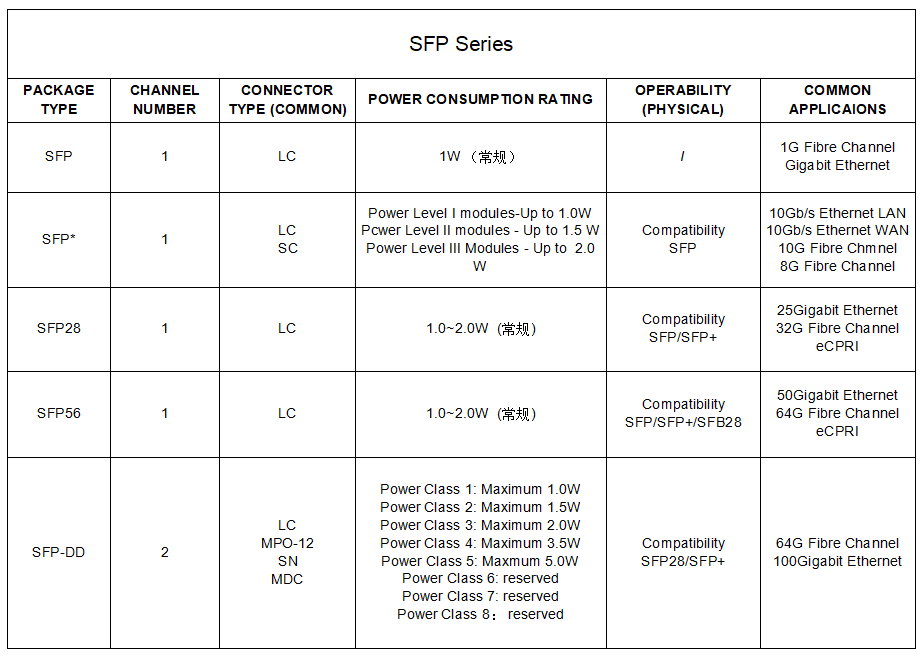What are the types of optical module packaging?
What is an optical module?
An optical module (Optical Transceiver), also known as a transceiver, is a core component in optical communication. It can complete the process of optical-electric/electric-optical signal conversion. It consists of optoelectronic devices, functional circuits, and optical interfaces. The optoelectronic device includes both the receiving and transmitting parts. In simple terms, the receiving part converts optical signals into electrical signals, and the transmitting part converts electrical signals into optical signals.

What is optical module packaging?
Optical module packaging refers to the physical form of an optical module. With the advancement of technology, optical module packaging has been continuously evolving. The size has become smaller, but the changes are not limited to appearance. It has been progressing in terms of speed, power consumption, distance, and cost. There are many types of optical module packaging, such as 1*9, SFF, GBIC, X2, XENPAK, XFP, etc., which are not commonly seen now. The following mainly introduces the common SFP series and QSFP series.
SFP Series Packaging Small Form-Factor Pluggable
SFP
It uses LC connectors and is smaller in size compared to GBIC fiber modules. It has higher integration and greatly increases the port density of network devices, adapting to the rapid development trend of networks.
SFP+
SFP+ is an upgrade of SFP with higher transmission rates, usually up to 8.5G or 10G (10 Gigabit). This module is smaller in size compared to the earlier XFP modules.
SFP28
SFP28 is designed for single 25GE access ports. Based on the SFP+ form factor, it supports the 25G Ethernet standard. SFP28 provides 25Gb/s error-free transmission, with a transmission distance of up to 100 meters on OM4 multimode fibers. It can be applied in high-density 25G Ethernet switches and network interfaces, promoting server connectivity in data centers. It adopts the popular SFP+ form factor, providing a cost-effective solution for upgrading enterprise 10G Ethernet connections.
SFP56
SFP56 is an optical module with a maximum rate of 53.125 Gbps. It can achieve a maximum transmission distance of 70m or 100m on OM3 or OM4 multimode fibers. It is widely used in 50GBASE Ethernet links and has seen some growth in the field of front-haul transmission with the rapid development of 5G.
SFP-DD
The "DD" in SFP-DD stands for Double Density, which doubles the number of channels compared to SFP. It provides a solution for aggregating up to 50Gbps NRZ or 112Gbps PAM4 per channel, and even future access solutions required for next-generation data centers like 200G (2x100G). SFP-DD maintains backward compatibility with current SFP/SFP+ high-speed interface solutions, laying the foundation for smooth upgrades from 25G AOC to 100G and enabling the upgrade from single-lane 50G to 100G.
SFP112
SFP112 achieves a single-channel rate of 100G. Whether it is a 4-channel QSFP28 or a dual-channel SFP-DD, the real innovation in 100G Ethernet is the SFP112. It uses a single lane instead of a combination of four lanes to achieve a speed of 100G. This means that there can be 100G single-fiber BIDI modules. Therefore, SFP112 is the true successor to 100G Ethernet and 10G Ethernet.
Summary of SFP series packaging:
QSFP Series Packaging Quad Small Form-Factor Pluggable
Product naming rule:
"Q" stands for "Quad," indicating that there are four electrical signal channels. The numeric part represents the maximum theoretical transmission rate supported by a single-channel in this package. For example, QSFP28 - "Q" stands for four channels, and "28" represents the maximum rate of each channel as 28Gbps. Therefore, the maximum bandwidth achievable with this package is 4*28G, which is higher than that of SFP optical modules.
QSFP+
40G QSFP+ optical modules use MPO fiber connectors and have a larger size compared to SFP+ optical modules.
QSFP28
The 100G pluggable optical module. This optical module uses LC/MPO interfaces. It has advantages such as smaller size, high port density, and low power consumption. It is the new generation of optical modules. Mainly used in applications such as 100G Ethernet and 128G fiber channel. It uses four different speed transmission channels. Common interface types include 100GBASE-SR4/LR4/ER4/ZR4 and 128GBASE-SW4.
QSFP56
An upgraded version of 40G QSFP+ and 100G QSFP28 optical modules, designed specifically for 200G Ethernet interconnects. QSFP56 can transmit speeds from 4x50Gb/s to 56Gb/s within the QSFP form factor.
QSFP-DD
Double Density Quad Small Form-Factor Pluggable. QSFP-DD is the preferred packaging for 400G optical modules, allowing data centers to grow and expand cloud capacity as needed. QSFP-DD modules use an 8-channel electrical interface with each channel supporting speeds of up to 25Gb/s (NRZ modulation) or 50Gb/s (PAM4 modulation), providing a solution for aggregating up to 200Gb/s or 400Gb/s (image from left to right, our company's 200G and 400G products). QSFP-DD provides a foundation for smooth upgrades from 25G AOC to 100G and establishes a technical platform for upgrading single-lane 50G to 100G.
QSFP112
QSFP112 is based on the current QSFP module and cage/connector system, aiming to support a channel speed of 112Gb/s in a 4x channel QSFP system and support the QSFP 400G interconnect ecosystem.
Summary of QSFP series packaging:
Expanded Packaging
OSFP Packaging
OSFP is a new pluggable packaging format with 8 high-speed electrical channels. It currently supports speeds of 200G, 400G, and 800G. The size of OSFP is slightly larger than QSFP-DD. The common interfaces for OSFP are LC and MPO. Currently, devices that support this packaging format are primarily Arista Ethernet devices and Mellanox IB devices.
CFP Packaging
To meet the high bandwidth requirements in data communication networks, CFP optical modules have evolved into various types, including CFP, CFP2, CFP4, and CFP8. CFP and its related series of packaging formats are generally larger in size, allowing for more components and supporting higher power consumption. Therefore, they are commonly used in the telecommunications field, especially in long-distance (>40km) optical communication applications.
NG-SFP Packaging
NG-SFP is a new type of pluggable small form-factor packaging format designed for next-generation high-port interconnects. NG-SFP utilizes external cable assemblies and offers high channel density, higher-speed interfaces, and lower cost. In recent years, with the increasing use of optical communication in data center environments, there has been accelerated development in optical module technology. Optical module products have rapidly entered the era of 100G and are actively evolving towards 400G technology. NG-SFP MSA focuses on 100G optical modules and covers applications within 2km. It continues the support for 2-lane electrical interfaces from DSFP, introduces the type 2 extended form factor, and can incorporate 4-lane electrical interfaces.
In addition to the aforementioned packaging formats, there are also other formats such as DSFP, SFP-DD112, NGSFP-DD, CPAK, CXP, and CDFP. However, since these formats are not widely used, I will not go into further detail about them.

Quick Links
Solutions





Products
Contact Info
+86 0755 2801 8089
Sophia19870721
www.uniqfiber.com
Intersection of the north side of Yingsan Road and the west side of
Gangkou Road, Yingzhou Economic Development Zone,Fuyang,
Anhui ,236000,China
Room 405, Floor 4, Building F, Baojiexun Industrial Park, No. 4,
Baolong 3rd Road, Longgang District, Shenzhen, 518116, China





